Queensland politicians' $91 million property portfolios

A new study by Paul Egan, Philip Soos and Lindsay David
reveals the 89 members of Queensland's legislative assembly have stake
in a total of 195 properties, valued at around $91 million — so how does
that affect their decision making?
Introduction
Following our analysis of Federal and Victorian Parliamentarians’
real estate holdings, attention turns to Queensland, where Premier
Campbell Newman has called a snap early election for 31st January, 2015.
Australia, including Queensland, is facing a chronic housing
affordability crisis. Housing price inflation has outstripped both rents
and household incomes since 1996, leading to a residential property
market that is unaffordable by both historic and international
comparison. Queensland’s elected representatives, like their federal,
state and territory counterparts have failed to address the root causes
of the crisis. Policies appear purposefully designed to encourage
speculation and rapid price appreciation, in spite of the skyrocketing
household debt burden and the harsh economic impacts of expensive land.
The public should critically consider whether state politicians’
property holdings are negatively influencing their decision-making
processes and causing them to ignore impartial evidence when formulating
housing and state taxation policies. The parliamentary register of
members’ interests provides a detailed report of the real estate
holdings of Queensland state politicians; a small window into the
potential conflicts of interest bedevilling our honourable members.
Real estate assets are often jointly owned with a spouse instead of
being in the sole ownership of the registered member. Properties can
form part of a family or business trust, or private superannuation fund,
with control over these entities exerted by either the beneficiary or
beneficiaries directly, or via a third party. Similarly, a politician
may have a minority, equal or majority share of the property asset
within established entities.
Analysis
Queensland parliamentarians are heavily invested in the property
game. The 89 members of Australia’s only unicameral legislative assembly
have stake in a total of 195 properties — an average of 2.2 properties
per member, conservatively valued at around $91 million, calculated by
multiplying the Brisbane median residential dwelling price of $466,500
(as at December 2014) by 195 properties.1
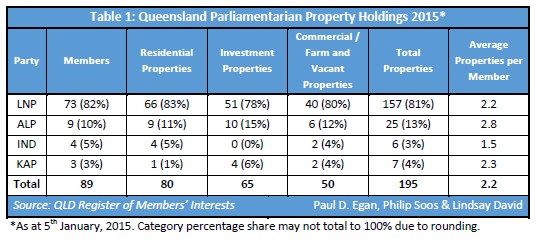
The actual value is probably significantly higher, for the Queensland
register allows for fine-grained analysis of the total lot size (m2)
for each politician, separated into the categories of residential,
investment and farm/commercial/vacant/other properties (see Appendix B).
As hypothesised in previous reports, politicians:
- generally have a principal place of residence on a large lot relative to the public average (often exceeding 1,000m2 in size) — nine Queensland parliamentarians live on a property exceeding 10,000m2;
- have substantial commercial, retail and industrial property interests;
- purchase a greater number of properties in prestige or premium locations, such as desirable inner-city and coastal areas;
- have significant interests in vacant land (some already approved
for large sub-divisions) and large grazing and cane farms — some
individual farm holdings exceed 10,000 hectares (ha) in size
(100,000,000m2); - regularly embed property assets in family and business trusts, and less often, private superannuation funds; and
- possess a number of surplus and holiday homes, some in desirable international locations, such as Thailand.
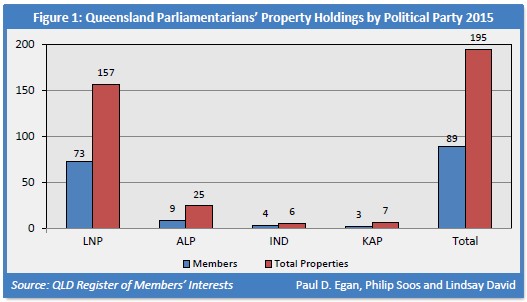
Queensland’s political class possess a substantial property
portfolio, with only 2 of the 89 members (2%) not owning any real
estate. Only a minority of holdings appear incomplete or mistakenly
undeclared in some register entries, usually for the lot size of
investment properties.
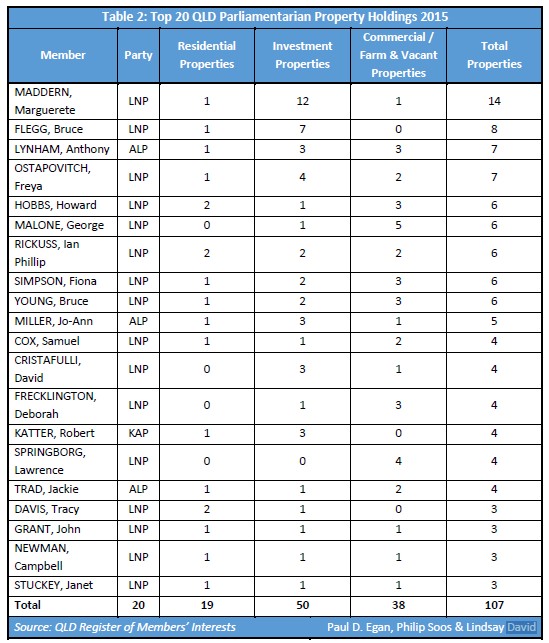
The data demonstrates the majority of politicians have a vested
interest in maintaining high housing and land prices, particularly the
76% of members with one or more mortgages over their own investments. It
would be naïve to assume politicians will put the common good before
their own self-interest, if it means the difference between a moderately
comfortable or a highly secure future retirement, or there are
significant family interests to consider. The risk of a sharp correction
in real estate prices and negative equity are just as real for those
three-quarters of parliamentarians in bondage to lenders, particularly
if they have multiple investments or are highly leveraged.
Queenslanders should be very sceptical about the supposed good
intentions of many of their elected members in addressing housing
affordability. Cynicism is warranted, for nationwide, politicians
regularly enact legislative and regulatory ‘reforms’ in direct
contravention of objective evidence, accelerating price growth and
enriching a multitude of land owners in the process.
Contrary to reason, parliamentarians assume heavy debt burdens and
record-low first home buyers are the new market normal. The urgent
entreaties from a series of Productivity Commission and Senate reports
to reform broken tax systems at the state level have gone unheard, even
though economic efficiencies and greater competitiveness would arise
from a shift of the taxation base onto those appropriating geo-rent (the
economic rent of land) and off labour and business.2
The property-rich Queensland Parliament cannot be trusted to act in
good faith on matters concerning real estate. Aversion to guiding
housing policy with firm evidence has a long history in many
jurisdictions, notably influenced by the projected future value of a
politician’s collective real estate holdings and corrosive lobbying by
the FIRE (finance, insurance and real estate) sector. A voter backlash
is also feared following any substantive reforms that reduce prices,
with large pockets of the citizenry having also gone ‘all in’ on
enormous property bets.
State and federal parliamentarians’ indifference to sound housing
policy suggests an unrepresentative parliament is consciously ignoring
the profound and negative outcomes of declining affordability upon
social justice and economic efficiency. A two-decade long blind-spot is
only possible if successive administrations have consistently
disregarded empirical evidence and sound research in favour of lobby
groups, populist measures and their own real estate portfolios.
Brisbane’s housing prices surged by 134% between the trough in 2000
and apparent peak in 2010. Prices softened after 2010, but rebounded
slightly from 2013 onwards. As of 2014, prices are 6% below the peak set
in 2010.3
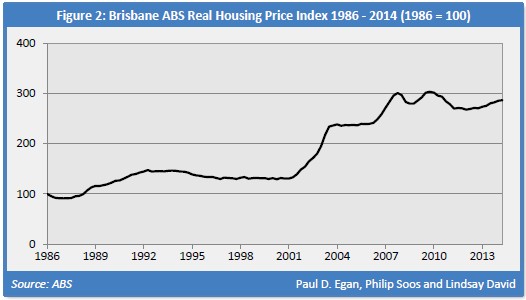
Total Queensland land prices have similarly ballooned, with the
prices to Gross State Product (GSP) ratio climbing from 141 to 304%
between 2001 and 2010, a relative increase of 116%. While Queensland
does not have the most inflated prices nationwide (which is Victoria),
prices have still reached lofty heights, principally from a sharp rise
in residential prices, rather than commercial, rural or other categories
of land. The ratio has since fallen to 235% as of 2014, though still
far above the long-run average.
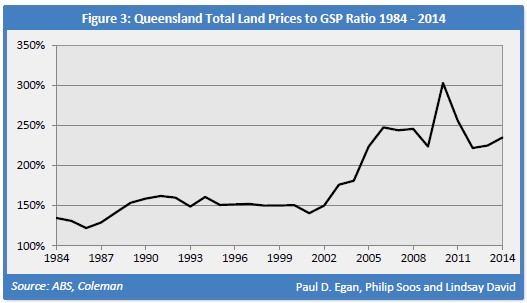
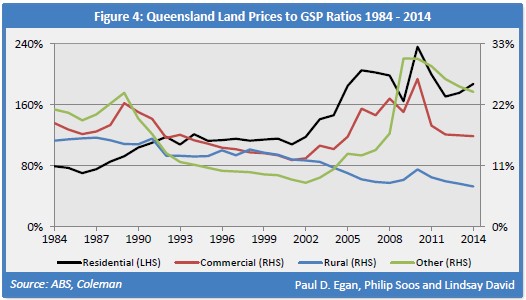
Real housing prices have risen substantially in every Australian
capital, though Brisbane is in the middle of the pack when considering
the size of the increase.
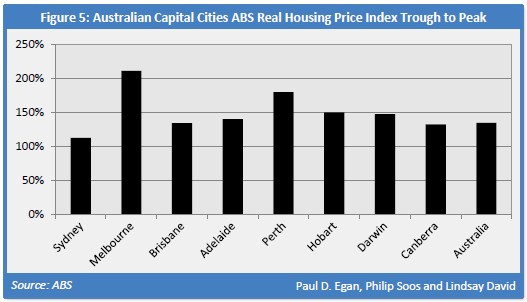
Debt-financed speculation has divorced skyrocketing land prices from
technical fundamentals, such as rents and household incomes. As a
result, gross yields have been compacted to 4.4 and 5.5% for houses and
units respectively as of December 2014.4 Net yields are
around half of gross yields, reinforcing claims that Brisbane’s property
investment model is strongly predicated on potential future capital
gains instead of sound cash flows.
The long-term trend in the price to income ratio demonstrates a
median-priced Brisbane dwelling could be purchased for around four times
household income until the early 2000s, but has since risen by 50% to
around six times in 2010.
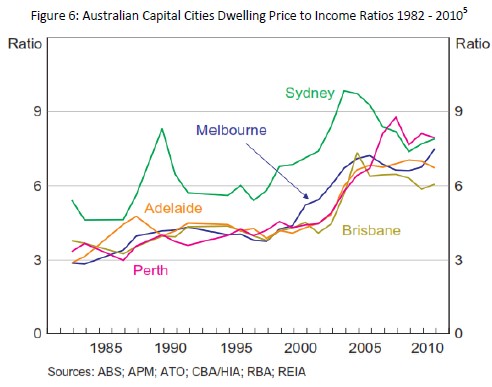
Recommendations
A range of matters influencing housing affordability are outside the
remit of Queensland parliamentarians, for instance, population growth,
broad economic settings and the provision of finance. Nevertheless,
state and territory governments are not powerless, wielding control over
an array of policy areas that can help prevent rapid price inflation
and reduce land prices.
What practical measures can Queensland politicians take to improve housing affordability?
Recommendation #1: More efficient use of the State Land Tax (SLT)
The SLT is an ideal tool to moderate both land price bubbles and
their subsequent devastating busts, and is already in the toolkit of
state and territory governments. Unfortunately, this tax has been
rendered comatose by a host of exemptions and concessional treatments.
The SLT requires broadening to include owner-occupied housing and
agricultural land, calculated on a per-square-metre value basis. The
narrow existing base and progressivity of the SLT incurs only a small
deadweight loss; the complete removal of exemptions and concessions
would reduce this deadweight loss to zero. The SLT should apply per land
holding, but not on an entity’s total holdings to encourage
development.
Recommendation #2: Changes to municipal rates calculations
Queensland local government rates correctly using site value (SV)
rating, which taxes the underlying land only. However, they are to be
condemned for the widespread use of minimum rates which provides a
direct subsidy to those owning more valuable sites. Ratepayers should be
outraged by this wealth transfer — an impost on their capital values as
well as annual charges.
Recommendation #3: Abolition of Stamp Duty tax
Conveyencing stamp duties should be removed, with the revenue shortfall met from an improved SLT.
Recommendation #4: Removal of the first home owners grant and boost
All housing grants act as a demand-side stimulus that further erodes
affordability. When combined with highly-leveraged mortgage loans, the
result is rapid price inflation that substantially outstrips the size of
the grant. These grants are a gift to vendors, not FHBs.
Recommendation #5: Greater investment in public housing
A substantial increase in funding for public housing would assist
long-term, low-income individuals and families reliant on social welfare
to exit the private rental market, ameliorating their financial stress.
We have an obligation to look after those who have difficulty managing
their affairs.
Recommendation #6: Tenancy law reform
Australian tenancy laws should adopt the higher standards enjoyed by
other Western nations. Queensland tenants’ limited rights include less
stability and security in tenure due to shorter lease terms (6 to 12
months on average), lower rental vacancy rates favouring landlords
during contractual negotiations, termination of leases for no reason,
and requisite landlord permission for minor alterations and pet
ownership.6
Recommendation #7: The adoption of ‘right to build’ laws
This policy encourages timely development of residential and
commercial property. Planning delays and uncertainties may raise land
costs, thus, this effect is negated by a right (positive presumption)
for developers and home builders to undertake activity, within specified
local and state government guidelines. If a development is opposed,
then the onus is upon the aggrieved party to take the developer to the
civil tribunal to prevent construction.
Recommendation #8: Elimination of state/local government infrastructure charges and levies
Government should reverse their preference for imposing direct
charges on developers to finance local infrastructure, resulting in
lower land costs. Governments can either adopt the Texan Municipal
Utility District (MUD) model or return to the original system of issuing
municipal bonds to finance local infrastructure and paying down debts
through council rates.
Recommendation #9: Streamlining of zoning processes
Land subdivision and zoning vacant land for residential use in
capital cities takes too long, generating considerable costs,
uncertainty and reducing developer competition. Comprehensive betterment
taxes should be applied to agricultural land that is rezoned for
commercial and residential purposes.
Recommendation #10: Removal of most urban growth boundaries (UGBs)
Except for ecologically or culturally sensitive regions of land,
there is no sound rationale for UGBs, as only a tiny fraction of
Queensland’s land mass is urbanised. Building further out on the fringe
may lower housing costs, but this may be more than offset by the rise in
transport costs.
Conclusions
A wide range of practical policies are available to policymakers to
lower housing and land costs, improving the lives of all Queenslanders.
Sadly, the aforementioned recommendations are not in the financial
interests of the political class and their ultimate constituents:
concentrations of capital, especially the FIRE sector. The sizeable
percentage of Queenslanders living as public (3%) and private tenants
(33%) are generally treated with contempt.7
State governments have squandered the opportunity to independently
pursue constructive, competitive federalism by simultaneously increasing
land value taxes and reducing inefficient, damaging payroll, insurance,
motor vehicle and stamp duty taxes. Similarly, councils were able to
lower construction costs by financing infrastructure through municipal
rates rather than developer charges, but chose not to do so.
Poor government decisions are attributable to the FIRE sector’s
deleterious effect on democratic processes, a stacked parliamentary
deck, and extensive lobbying and soft corruption that undermines the
public good. The political parties and rentier class have an unspoken
accord to preserve privilege for the rich and to further redistribute
wealth and income upwards in a ‘flood up’ effect. The degenerate state
of contemporary politics means voters generally do not understand the
rampant inefficiencies wrought by the FIRE sector.
Substantive reforms are not certain even if politicians were aware of
the economic harm unfolding, because they lack courage to confront the
powerful FIRE sector. The stranglehold over democratic processes
virtually guarantees maintenance of the status quo, unless a fresh
reform movement challenges unjustified privilege. Honest public
discourse, genuine taxation reform, decentralisation of political power
and a complete reconstruction of the FIRE sector is essential to
Queensland moving to a more efficient, productive and meaningful economy
that serves the common interest.
This is the complete version of an abridged article by the authors published by Fairfax Media earlier today.
Endnotes
1 RP Data (2015). See Appendix A for each individual Parliamentarian’s holdings.
2 PC (2004); Senate (2008).
3 The ABS measure of housing prices is not quality-adjusted, so the index overstates the trend.
4 RP Data (2015).
5 Fox and Finlay (2012: 18 – Graph 4).
6 Kelly (2013).
7 HPW (2013: 4).
References
- Fox, Ryan and Richard Finlay. (2012). 'Dwelling Prices and
Household Income', Bulletin December Quarter, Reserve Bank of Australia,
Sydney. - HPW. (2013). 'Housing 2020 Strategy', Department of Housing and Public Works, Queensland Government, Brisbane.
- Kelly, Jane-Frances. (2013). 'Renovating housing policy', Grattan Institute, Melbourne.
- PC. (2004). 'First Home Ownership', Productivity Commission, Melbourne.
- RP Data (2015). 'RP Data CoreLogic December Hedonic Home Value Index Results', RP Data
- Senate. (2008). 'A good house is hard to find: Housing
affordability in Australia', Select Committee on Housing Affordability
in Australia, Canberra.

No comments:
Post a Comment